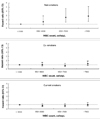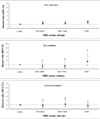Abstract
Figures and Tables
Fig. 1

Fig. 2

Table 3

CI, confidence interval; HR, hazard ratio.
*Participants with any of the following features at study entry were excluded: missing data on leukocyte count, existing cancer, and missing data on questionnaire.
†The rate per 100,000 person-years is given, standardized to the age distribution of men in the 1995 Korean national population.
‡The Cox proportional hazards model was adjusted for age, BMI, total cholesterol, smoking status, regular exercise, alcohol consumption per day (none, 0 - 29.9 g/day, ≥ 30 g/day), frequency of meat intake per week (nearly none, 1 - 2, ≥ 3), hypertension, and diabetes.
Table 4

CI, confidence interval; HR, hazard ratio.
*Participants with any of the following features at study entry were excluded: missing data on leukocyte count, existing cancer, and missing data on questionnaire.
†The rate per 100,000 person-years is given, standardized to the age distribution of women in the 1995 Korean national population.
‡The Cox proportional hazards model was adjusted for age, BMI, total cholesterol, smoking status, regular exercise, alcohol consumption per day (none, 0 - 29.9 g/day, ≥ 30 g/day), frequency of meat intake per week (nearly none, 1 - 2, ≥ 3), hypertension, and diabetes.
Table 5

CI, confidence interval; HR, hazard ratio.
*Participants with any of the following features at study entry were excluded: missing data on leukocyte count, existing cancer, and missing data on questionnaire.
†The rate per 100,000 person-years is given, standardized to the age distribution of men in the 1995 Korean national population.
‡The Cox proportional hazards model was adjusted for age, BMI, total cholesterol, smoking status, regular exercise, alcohol consumption per day (none, 0 - 29.9 g/day, ≥ 30 g/day), frequency of meat intake per week (nearly none, 1 - 2, ≥ 3), hypertension, and diabetes.
Table 6

CI, confidence interval; HR, hazard ratio.
*Participants with any of the following features at study entry were excluded: missing data on leukocyte count, existing cancer, and missing data on questionnaire.
†The rate per 100,000 person-years is given, standardized to the age distribution of women in the 1995 Korean national population.
‡The Cox proportional hazards model was adjusted for age, BMI, total cholesterol, smoking status, regular exercise, alcohol consumption per day (none, 0 - 29.9 g/day, ≥ 30 g/day), frequency of meat intake per week (nearly none, 1 - 2, ≥ 3), hypertension, and diabetes.




 PDF
PDF ePub
ePub Citation
Citation Print
Print




 XML Download
XML Download